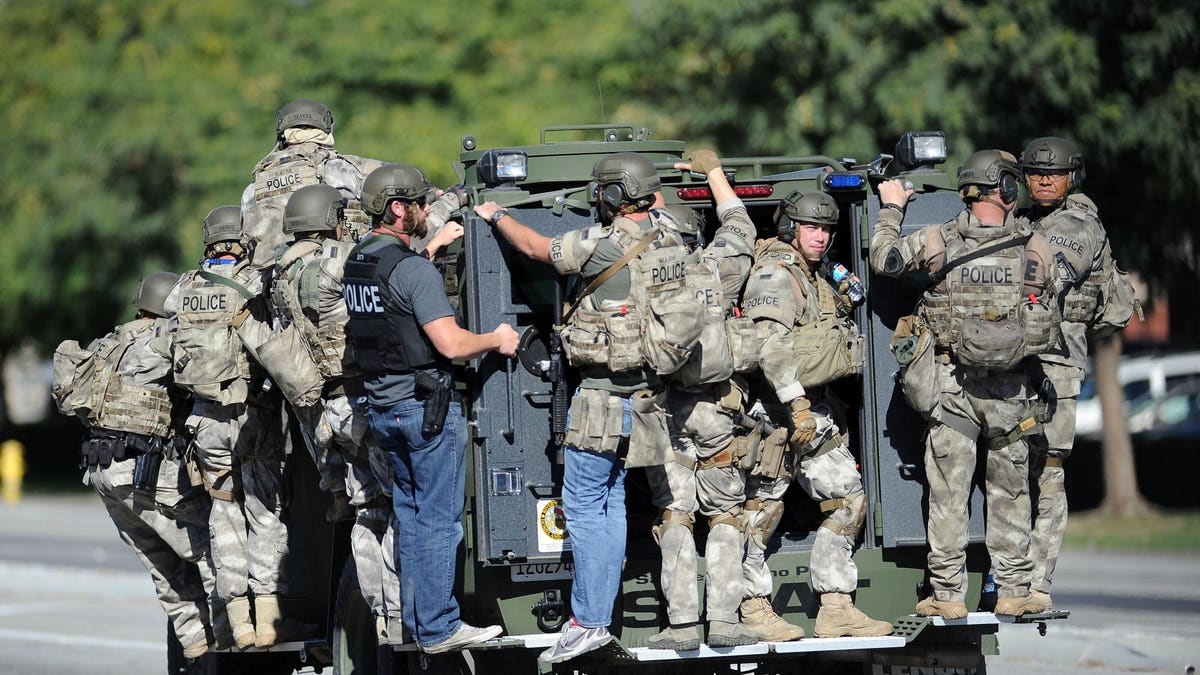
Dec. 2, 2015 - A SWAT vehicle carries police officers near the scene of the shooting in San Bernardino, Calif. (AP)
Over the next several weeks, we will all learn the sad and grim details about the tragic shooting in San Bernardino, California, that left 14 people dead, and 21 injured.
For tactical law enforcement officers across the United States – often called SWAT teams – the events in California are a reminder that they are on the front lines against criminals and terrorists, often armed with powerful and deadly weapons.
Due to these reccurring threats to public safety, it is critical that tactical officers are equipped and trained to deal with these violent situations. Fortunately, there is an important government program that provides law enforcement across the nation with surplus military equipment. Known as the Department of Defense’s 1033 program, it has provided thousands of police departments across the United States with important tools like body armor, specialized weapons, and armored vehicles.
Despite the success of the program, in response to accusations that our police forces have become militarized, there have been calls in Congress and from elected officials around the nation to end or drastically curtail the 1033 program. This would be a mistake that could seriously hamper police departments from being able to manage events like San Bernardino.
San Bernardino is a stark reminder of the importance of the 1033 program. To keep America safe, it is our duty is to ensure that tactical law enforcement officers getting equipment through the essential 1033 program have both the need and the training to use it effectively and judiciously.
To address legitimate concerns about law enforcement acquiring equipment from the military, a responsible alternative would be to implement meaningful reforms to the 1033 program to achieve two primary goals:
First, ensure that the equipment is given to police departments based on need, not want. If a police department seeks access to this equipment, they must be able to demonstrate a credible threat. They must also have sufficient personnel to manage an effective tactical team. For smaller police departments, this may mean that they could partner with neighboring agencies to create a single, effective SWAT team.
Second, because we are talking about military hardware, the way it is used on the battlefield is not necessarily how it should be used on American streets. Therefore, we must ensure that the equipment is paired with appropriate training, oversight, and documentation. This will help eliminate the misuse or overuse of the equipment by police departments, which can erode public support for law enforcement.
To achieve these two goals, tactical officers across the United States are developing national training standards, building comprehensive instruction programs and working closely with the White House, Congress and other elected leaders. We are confident that these concerted efforts will improve the implementation of the 1033 program.
Hopefully, one day we will live in a society devoid of criminal assailants intent on causing unfathomable violence and terror. But until we get there, San Bernardino is a stark reminder of the importance of the 1033 program. To keep America safe, it is our duty to ensure that tactical law enforcement officers getting equipment through the essential 1033 program have both the need and the training to use it effectively and judiciously.




















